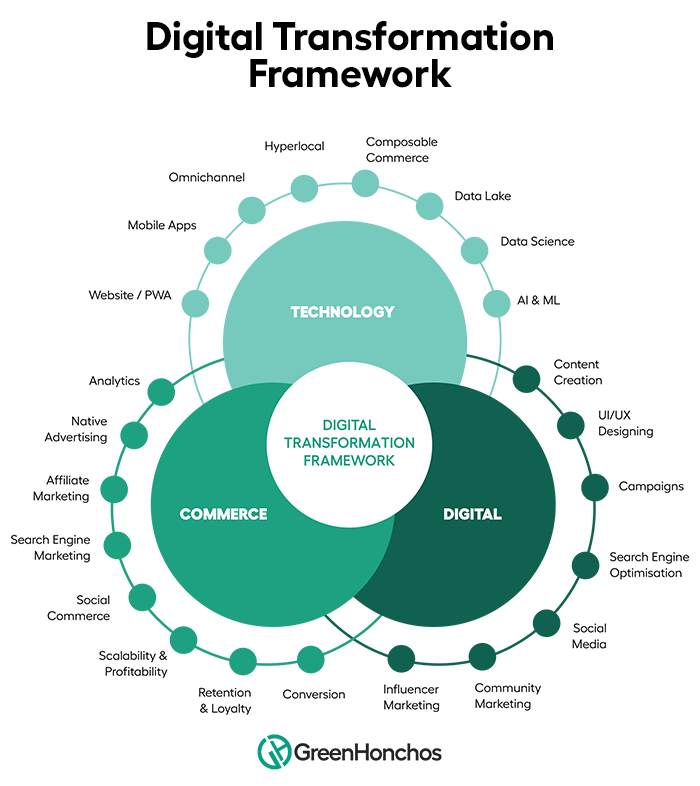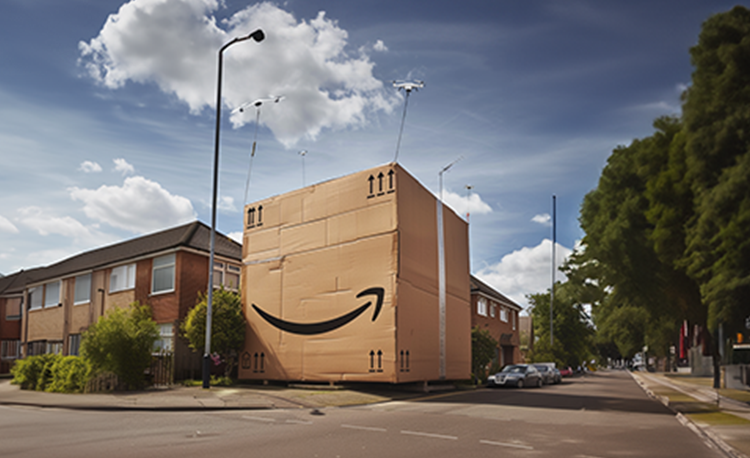What is the Marketplace model of eCommerce and how to leverage it for scale?
There is no denying the fact that marketplaces have been the biggest driving forces in…

In the era of digitalization, the landscape of global retail businesses is undergoing a drastic transformation. Starting in 2021, the year emerged as a watershed moment in the digital revolution, making the world take the concept of digital transformation seriously and spend on it. This resulted in the soaring height of the global digital transformation market size staggering up to 1.59 trillion US dollars, representing approximately a 20% increase from the previous year. It looked promising to invest in digitalization and perplexed into a profound shift reshaping how global brands (especially retail) operate and interact with their markets.
Since then, the figures for the transformation have become more astounding. With a value of USD 1.91 trillion in 2022, the global digital transformation market become a broad indicator towards digital integration. The trajectory is even more compelling, with projections indicating growth from USD 2.27 trillion in 2023 to an eye-opening USD 8.92 trillion by 2030. This amplifies the CAGR growth of 21.6%, underscoring the rapidly expanding scope and scale of digital transformation across the retail industry.
The catalyst of this accelerating pace of digital revolution can be traced back to the global pandemic when businesses scrambled to the unprecedented challenges brought forth by COVID-19. Digital transformation ceased to be the only option and became a necessity with the rise of remote work, dependency on online grocery shopping, etc. that acted as a significant impetus, compelling retail businesses to embrace digital technologies like never before.
In response to the pandemic, leading global brands such as Levi’s adapted swiftly by introducing services like curbside pickup, scheduled appointments, and the option for customers to buy online and pick up in-store. Additionally, Levi’s enhanced its in-store experience by implementing mobile, contactless payment solutions. During this period, direct-to-consumer (D2C) sales constituted 36% of Levi’s revenue. Embracing these strategies further in 2023, D2C sales grew to represent 44% of Levi’s total revenue, prompting the brand to set ambitious goals. Today, Levi’s plans to expand its D2C operations to contribute 55% of its overall revenue and to triple its e-commerce sales by 2027.
This shows why digital transformation becoming the need of the hour. Adding to this, one of the digital technologies such as Cloud Technologies, standing at the vanguard of this digital revolution, have not just been adopted but are being integrated into the fabric of organizational operations. Even later, adapting existing IT solutions with cloud extensions became the most common approach to digital transformation since 2022.
Similarly, digital commerce become the second most dominating trend across the digital landscape making the transformation underscoring a broader shift towards a more agile, responsive and interconnected business environment. Especially global eRetail brands have been making the most of these trends by implementing the latest digital technologies and innovating the way people shop.
Looking at these advancements, one such opportunity that will be looked promising and cherished by retailers is Virtual Try On. This means consumers are looking for innovative ways of seeking immersive online experiences from global brands they are familiar with whereas growth-focussed businesses doing their best to meet the expectations.
Sounds interesting, right? Read more as this blog delves into the depths of the digital transformation framework and how it’s shaping not only global brands but also redefining the very way we perceive business operations and customer engagement in the digital era. Join us as we explore the intricate dynamics of the digital transformation framework and its far-reaching implications for global brands.
The Digital Transformation Framework is a comprehensive set of guidelines and a strategic blueprint that empowers brands to not only comfort challenges but also chart a transformative course through the digital landscape. This holistic framework serves as a versatile tool in the arsenal of global brands, allowing them to keenly assess their existing landscape and leverage the potential of digital innovations to propel themselves ahead of their competitors.
At its core, the digital transformation framework acts as a compass guiding global brands on a journey to not only address challenges but to proactively shape their future. It’s the conduit through which brands gain insights, harness the capabilities of digital technologies and strategically pivot their current state towards a future where brands can not only thrive but lead in their respective industries.
A comprehensive digital transformation framework is pivotal for elevating a brand to new heights. This framework should encompass strategies that enable a brand to emerge successfully from any sort of disarray and identify areas where overlap hinders progress.
This framework should always function as a multi-faceted program, meticulously designed to yield scalable and profitable outcomes. By addressing these key areas, the framework ensures a smooth transition for the brand towards digital excellence, positioning itself for sustainable growth in an ever-evolving digital landscape.
Consider the framework depicted in the image below. It offers a well-defined roadmap of strategies that a brand can adopt to establish its business objectives and pinpoint the platforms instrumental in achieving these goals.

The Digital Transformation Framework (DTF) presents a holistic and integrated approach for global brands, ensuring alignment between marketing teams and management with business objectives, even as market trends shift. It serves as a guide through the upheavals brought about by emerging technologies and changing consumer patterns.
Key advantages of this framework include aiding global brands to scale their operations effectively during periods of disruption:
Optimizing Business Processes – Through careful planning and selecting appropriate digital platforms and tools, brands can boost productivity and enable process automation by centralizing data for improved efficiency. This approach not only enhances the brand relevance and efficiency but also increases profitability potential, reduces labour costs and keeps the brand in step with current market trends.
Enabling Strategic Decision-Making – A digital transformation framework is crucial for leveraging data, a key factor in a brand’s success. Such a framework empowers brands to base their decisions on data, fostering the development of robust business strategies.
Gaining Competitive Edge – Embracing the latest digital technologies and aligning them with business objectives is essential for staying ahead of the competition. The framework guides brands towards success, enabling them to surpass their competitors in a constantly evolving market.
Improving Customer Experience-Effective planning leads to superior outcomes, paving the way for enhanced customer experiences. A digital transformation framework keeps your brand current with trends, meeting customer expectations through various channels like live chats, social media, emails, apps, etc. by improving engagement and satisfaction.
Forever New is a renowned global fashion brand, specializing in western wear for women. It offers a wide range of stylish dresses, tops, coats, and fashion accessories, catering to the contemporary woman.
Before its digital transformation, Forever New encountered several challenges:
Inefficient Tech-Stack:The brand’s technology infrastructure was not optimized for peak performance, hindering its online capabilities.
Lack of Integrated E-commerce Growth Strategy :There was no cohesive approach to eCommerce, limiting the brand’s online market penetration.
Stagnant Online Revenue Growth:Revenue from online channels was not increasing, indicating a need for a revamped digital strategy.
Slow Organic Online Growth:The brand’s online presence was growing at a sluggish pace, failing to capture a larger digital audience.
Limited Omnichannel Growth:There was a noticeable gap in creating a seamless omnichannel experience for customers.
GreenHonchos stepped in with a robust digital transformation framework, implementing the following solutions:
End-to-End D2C Strategy:A comprehensive Direct-to-Consumer (D2C) strategy was developed, integrating technology and digital solutions for scalability.
360-Degree Impact on Online Retail Space:GreenHonchos transformed Forever New’s online presence, creating a significant impact across all digital retail facets.
Positioning as a Premium Digital Brand:The brand was strategically positioned as a top choice in the premium women’s western wear segment among digital shoppers.
Content-to-Commerce Journey:Enabled a seamless transition from engaging content to online purchases, driving repeat business.
Robust Online Branding Strategy:An integrated branding strategy was developed, focusing on organic, sustainable, and profitable online growth.
The collaboration with GreenHonchos led to a remarkable transformation for Forever New. By overcoming the initial challenges with a well-executed digital strategy, the brand experienced enhanced online growth, improved revenue streams from digital channels, and established a strong presence in the digital fashion retail space. This case study exemplifies the power of targeted digital solutions in overcoming market challenges and redefining a brand’s online identity and success.

In conclusion, the journey of digital transformation is both challenging and rewarding as we have seen in the case of Forever New. Embracing a digital transformation framework is not just adopting new technologies, it’s a strategic move towards redefining business processes, meeting customer expectations and enhancing customer experience, driving sustainable growth, etc.
This approach improved operational efficiencies and also positions brands competitively in the dynamic digital marketplace. As discussed, successful digital transformation leads to significant business benefits, including increasing revenue, market relevance and customer loyalty.
Looking ahead, it’s evident that the future of retail is intrinsically linked to how effectively global brands can adapt and evolve with this digital paradigm.
Using digital marketing strategies can drastically increase your brand awareness which ultimately leads to more sales and repeat business. Looking for a Digital Marketing agency that understands the needs of your D2C eCommerce? Check out GreenHonchos – a Full-Stack D2C enabler offering services like growth marketing, eCommerce digital marketing, marketplace management, social media marketing and much more! For more valuable insights on eCommerce marketing and D2C growth strategies, follow us on LinkedIn , Facebook , Instagram and Twitter or visit our website .


In the evolving world of modern retail, success isn’t just...


In today’s global eCommerce ecosystem, marketplaces have b...


In the fast-paced digital world, time is everything, especia...


As Henry Ford wisely said, “The only real mistake is the ...


For many years, July was often considered a slow month for r...


With the overall increase in global retail sales figures, th...


In the...


In the...


The Indian eCommerce industry is transforming at a faster pa...


It’s been a while since Meta introduced its contender to T...


Marketing your brand at Amazon can exponentially boost your ...


The pandemic has brought about a lot of changes and ada...


There is no denying the fact that marketplaces have bee...


The post-pandemic world has made brands realise the importan...


We are living in a digital age where every brand is coming a...


Digital media accounted for 64.4% of global ad sp...


Marketers since generations have banked heavily on the ...


Social Media has grown rapidly in the past couple of years. ...


The first step towards building a successful business i...

Want to take your eCommerce business to the next level? We help businesses make the most at every stage - from product conceptualization to achieving the maximum optimization & ROI on business operations.
B-24, Sector 3, Noida, GB Nagar,
Uttar Pradesh 201301, India
Mazaya Business Avenue, Tower AA1,
FZCO, Office #18, 36th floor, JLT, Dubai, UAE
1st Floor, Plot-183, Indiranagar Stage 2,
Bengaluru, Karnataka,
560038, India